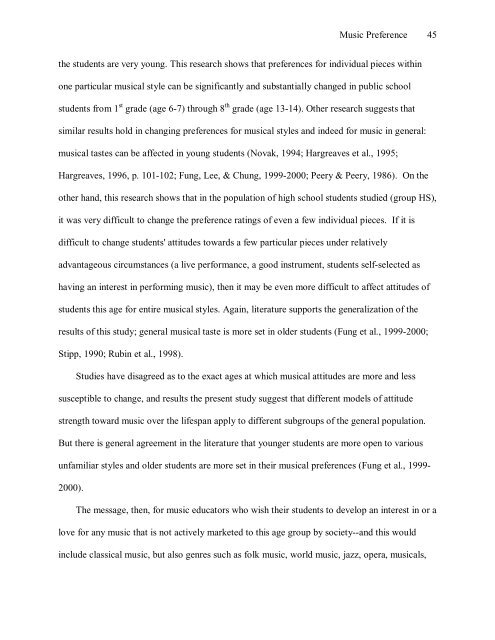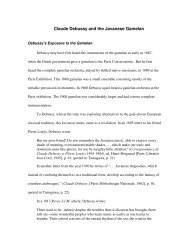Music Preference 1 - Brent Hugh's personal and business web pages
Music Preference 1 - Brent Hugh's personal and business web pages
Music Preference 1 - Brent Hugh's personal and business web pages
Create successful ePaper yourself
Turn your PDF publications into a flip-book with our unique Google optimized e-Paper software.
<strong>Music</strong> <strong>Preference</strong> 45<br />
the students are very young. This research shows that preferences for individual pieces within<br />
one particular musical style can be significantly <strong>and</strong> substantially changed in public school<br />
students from 1 st grade (age 6-7) through 8 th grade (age 13-14). Other research suggests that<br />
similar results hold in changing preferences for musical styles <strong>and</strong> indeed for music in general:<br />
musical tastes can be affected in young students (Novak, 1994; Hargreaves et al., 1995;<br />
Hargreaves, 1996, p. 101-102; Fung, Lee, & Chung, 1999-2000; Peery & Peery, 1986). On the<br />
other h<strong>and</strong>, this research shows that in the population of high school students studied (group HS),<br />
it was very difficult to change the preference ratings of even a few individual pieces. If it is<br />
difficult to change students' attitudes towards a few particular pieces under relatively<br />
advantageous circumstances (a live performance, a good instrument, students self-selected as<br />
having an interest in performing music), then it may be even more difficult to affect attitudes of<br />
students this age for entire musical styles. Again, literature supports the generalization of the<br />
results of this study; general musical taste is more set in older students (Fung et al., 1999-2000;<br />
Stipp, 1990; Rubin et al., 1998).<br />
Studies have disagreed as to the exact ages at which musical attitudes are more <strong>and</strong> less<br />
susceptible to change, <strong>and</strong> results the present study suggest that different models of attitude<br />
strength toward music over the lifespan apply to different subgroups of the general population.<br />
But there is general agreement in the literature that younger students are more open to various<br />
unfamiliar styles <strong>and</strong> older students are more set in their musical preferences (Fung et al., 1999-<br />
2000).<br />
The message, then, for music educators who wish their students to develop an interest in or a<br />
love for any music that is not actively marketed to this age group by society--<strong>and</strong> this would<br />
include classical music, but also genres such as folk music, world music, jazz, opera, musicals,





